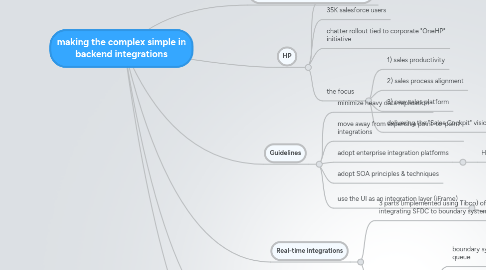
1. Lessons learned
1.1. Know your platforms
1.1.1. train everyone to understand the platforms well
1.1.2. SFDC is cloud-based
1.1.2.1. ramifications on security, API quotas, query time-outs &c
1.2. Understand your organization security guidelines
1.2.1. used proxies to go thru firewall
1.3. Identify your integration patterns
1.4. Analyze data/transaction volumes early
2. Batch integrations
2.1. Using informatica
2.1.1. files from SFDC are loaded using informatica, every 10min, transformed to enterprise data-model, & sent thru Tibco queuesto boundary systems
2.1.2. million records every day
3. Real-time integrations
3.1. 3 parts (implemented using Tibco) of integrating SFDC to boundary systems
3.1.1. SFDC upsert web services
3.1.2. SFDC query web services
3.1.3. Push topics in Tibco
3.2. Opty example
3.2.1. boundary system gets opty thru Tibco topic queue
3.2.2. button in SFDC sends opty from boundary system
3.2.3. boundary system updates SFDC using web service in Tibco
4. Guidelines
4.1. minimize heavy data replication
4.2. move away from expensive point-to-point integrations
4.3. adopt enterprise integration platforms
4.3.1. HP used Informatica & Tibco
4.4. adopt SOA principles & techniques
4.5. use the UI as an integration layer (iFrame)
4.5.1. instead of bringing data from external apps, embed a page in salesforce
5. HP
5.1. 300K employees
5.2. 35K salesforce users
5.3. chatter rollout tied to corporate "OneHP" initiative
5.4. the focus
5.4.1. 1) sales productivity
5.4.2. 2) sales process alignment
5.4.3. 3) new sales platform
5.4.4. delivering the "Sales Cockpit" vision
5.4.4.1. presentations done directly from the system
